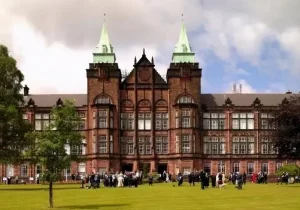
Virginia Polytechnic Institute and State University (officially abbreviated as Virginia Tech or VT), Viginia Polytechnic Institute and State University diploma. referred to as Virginia Tech University, Located in the east coast of the United States, Blacksburg, Viginia Polytechnic Institute and State University degree. Virginia, is a public research university based on engineering, buy fake Viginia Polytechnic Institute and State University diploma. enjoys a high reputation in the field of engineering, fake Viginia Polytechnic Institute and State University degree. strong faculty, 20 professors have been elected as academicians of the American Academy of Sciences or the American Academy of Engineering, and 29 AIAA Fellow, 25 ASME Fellow, There are 29 IEEE Fellows and 11 ACM Fellows.
Founded in 1872 as a land-grant university focused on agriculture and science and technology, Virginia Tech has now developed into a first-class research university in the United States, and is one of the few public universities in the United States to retain non-full-time military colleges (the other is Texas A&M University). The school has a 2,600-acre campus with 125 campus buildings, the main campus is located in Blacksburg, and there are research and education centers in Washington, D.C., Switzerland, and the Dominican Republic. The school is also famous for its football, and its mascot is an anthropomorphic Turkey named “Hokies”, which is often used as a name for the school and its students.
Virginia Tech University has the top engineering school in the United States, engineering undergraduate ranking 13th in the United States (US News 2020), more than Columbia University, University of California, Los Angeles and other famous schools. Among them, industrial manufacturing ranked 4th, civil engineering ranked 9th, environmental engineering ranked 10th, and architecture ranked 6th. The graduate program ranked 40th in computer science, 28th in Earth Science, and 15th in aerospace engineering, and the school’s computer System, System X, was once the seventh supercomputer in the world and the first supercomputer in the world’s university system.
In 1872, under the Land Grant Act, the Virginia Legislature used federal funds to purchase the facilities of the Preston and Olin Institute, which was on the point of bankruptcy. The school was originally a Methodist school in suburban Montgomery County. The Commonwealth of Virginia converted the site into a government grant and established a military College called the Virginia Agricultural and Mechanical College.
During the reign of the College’s seventh President, John McLaren McBride (tenure: 1891-1907), Virginia A&M College changed its academic system to a traditional four-year institution, This change led to the school changing its name to the Virginia Agricultural and Mechanical College and Polytechnic Institute. Since references to the school often omit the “College of Agriculture and Engineering” part of the school’s name, the name of the school was officially reduced to Virginia Polytechnic Institute (often referred to as VPI) in 1944. During this period, Virginia Tech merged with Radford College (now Radford University /Radford University), a women’s university. In 1923, Virginia Tech reduced the four-year mandatory cadets to two years, and began teaching at the Norfolk campus of the College of William and Mary in 1931. Students who complete two years at the Norfolk campus of the College of William and Mary can then transfer to Virginia Tech for the remaining two years.
Much of Virginia Tech’s success can be attributed to its 13th president, Thomas Marshall Hahn (1962-1974). His vision was to gradually transform Virginia Tech into a major research university. To achieve this goal, about 1,000 students were added each year, dormitories were built, more professors were hired (more than 100 were added in 1966 alone, for example), and budgets for academic research were increased. During the Hahn Presidency the University saw its first Rhodes Scholar in W.W. Lewis, class of 1963. Hahn also ended a partnership with Radford University, removed the two-year mandatory cadet program, and allowed women to join the cadet Corps. Virginia Tech was the first school in American history to admit women into the Corps.
Hahn’s other controversial plan did not fully materialize. He wanted to change the name of Virginia Polytechnic Institute to Virginia State University, a name that better reflected the school’s transformation into a full-fledged research university. If his plan was successful, Virginia Tech would take over what was then known as Virginia State College (now Virginia State University /Virginia State University) as a historically black college. This plan did not materialize, and as a compromise, the school changed its name to the current Virginia Polytechnic Institute and State University. In the late 1970s, the acronym Virginia Tech began to be used to replace V.P.I. for the school’s athletic teams, and the media began to use the new acronym to broadcast game scores. In the early 1990s, school officials began adopting the acronym and gave the name “Virginia Tech” the same effect as the full name of the school. Many of the school’s documents use this abbreviation, but diplomas and transcripts still use the full name. Another common abbreviation is “VT”, also found in the school’s domain name (vt.edu).
At present, the official names of the school are “Virginia Polytechnic Institute and State University” and “Virginia Tech”/” Virginia Tech “: The two names have the same effect, but the former is commonly used in formal situations. In certain cases, “VT” or “Va.Tech” may be used to refer to the school, but the abbreviation of the full name of the school (” VPI&SU “, “VPI&SU”), “VPI and SU” or “VPI”) and the so-called “Virginia Tech University” are not recognized and prohibited.














